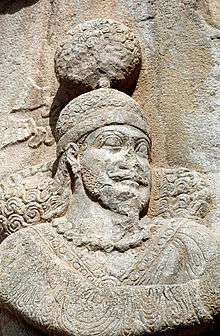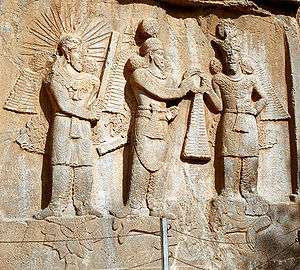Ardashir II
Ardashir II (Middle Persian 𐭠𐭥𐭲𐭧𐭱𐭲𐭥, New Persian: اردشیر نیکوکار, Ardashir), was the eleventh king (shah) of the Sasanian Empire, ruling from 379 to 383. He was the brother of his predecessor, Shapur II (r. 309–379), under whom he had served as governor-king of Nodardashiragan, where he fought alongside his brother against the Romans. Ardashir II was appointed as his brother's successor to rule interimly till the latter's son Shapur III reached adulthood. Ardashir II's short reign was largely uneventful, with the Sasanians trying to defuse instability in Armenia.
| Ardashir II 𐭠𐭥𐭲𐭧𐭱𐭲𐭥 | |
|---|---|
| King of Kings of Iran and Aniran | |
 Relief of Ardashir II in Taq-e Bostan | |
| Shahanshah of the Sasanian Empire | |
| Reign | 379 – 383 |
| Predecessor | Shapur II |
| Successor | Shapur III |
| Born | 309/10 |
| Died | 383 |
| Issue | Zruanduxt |
| House | House of Sasan |
| Father | Hormizd II |
| Religion | Zoroastrianism |
Ardashir II was seemingly a strong-willed character, and is known in some sources by the epithet of nihoukar ("the beneficent").[1]
Name
Ardashir is the Middle Persian form of the Old Persian Ṛtaxšira (also spelled Artaxšaçā, meaning "whose reign is through truth").[2][3] The Latin variant of the name is Artaxerxes.[2] Three kings of the Achaemenid Empire were known to have the same name.[2]
Background
Ardashir was the son of shah Hormizd II (r. 302–309), who was killed by the Iranian nobility whilst hunting. He was succeeded by Adur Narseh, who, after a brief reign which only lasted a few months, was too killed by the nobles,[4] who then proceeded to blind the second,[5] and imprison the third (Hormizd, who later managed to escape to the Roman Empire).[6] Ardashir's infant half-brother Shapur II, who was only slightly older than him, was crowned as king by the nobles so that they could gain greater control of the empire, which they were able to do until Shapur II reached his majority at the age of 16.[7][5]
Ardashir, before becoming king of the Sasanian Empire, was governor-king of Nodardashiragan from 344 to 376. It is believed that during his tenure he took part in the defense of the Sasanian Empire with Shapur when it was invaded by the Roman Emperor Julian (r. 361–363).[1] In 379, Shapur II designated Ardashir as his successor, and made him vow to abdicate when Shapur's son, Shapur III reached adulthood.[1] This led to some Armenian writers to wrongly state that Ardashir was Shapur's son.[1]
Reign
During his reign as shah of the Sasanian Empire, events in Armenia seemed to occupy Ardashir's attention. The son of Arshak II, Pap, had been murdered during Shapur's reign and the Romans had replaced him with a certain Varazdat who was a member of the Arsacid family. However, real power was in the hands of Mushegh I Mamikonian, a noble in the Armenian court. Mushegh was suspected of having conspired with the Emperor of Rome and was murdered by Varazdat.[8] This act roused the indignation of Mushegh's brother Manuel who rebelled against Varazdat and with the support of Iran deposed him and placed upon the Armenian throne Zarmandukht, the widow of Papas who was the mother of Arshak III and Papas' son, who made Manuel the sparapet (commander-in-chief). In return for their services, Manuel allowed the Iranians to maintain a garrison in Armenia.[8]
But this arrangement did not work for long. A nobleman named Merujan wrongly informed Manuel that the commandant of the Iranian garrison desired to capture him. Enraged, Manuel fell upon the ten thousand Iranian soldiers stationed in Armenia and murdered them. But Manuel died soon afterwards and confusion followed.[8] Desirous of maintaining peace in the borderlands, the Roman Emperor Theodosius I and Ardashir decided upon a treaty. But Ardashir was killed in 383 by the Iranian nobility before the treaty could be signed. The reason behind his murder was due to his continuation of Shapur's policy of restricting the authority of power-hungry nobles.[1] Nevertheless, the treaty was the eventually signed and ratified by his nephew and successor Shapur III in 384. Ardashir was survived by his daughter Zruanduxt, who married the King Khosrov IV of Armenia.[8]
Coins

The coins minted under Ardashir imitates him wearing the same dome-shaped crown worn by the first Sasanian shah, Ardashir I (r. 224–242). The reverse shows the traditional fire altar flanked by two attendants, but in some cases also shows the shah's head appearing from the fire, which may symbolize the royal xwarra ("glory").[1] The inscription of his coins are usually "Ardashir, king of kings of the Iranians" whilst rare instances of "and of non-Iranians" also being part of the inscription.[1]
Rock relief

Ardashir, like his forefathers, also had himself memorialized on reliefs. However, instead of using the sites of Pars (present-day Fars Province) as a place for his relief, he instead had a relief carved in Taq-e Bostan in the province of Media (near present-day Kermanshah).[1] The relief shows three standing figures wearing regalia; Ardashir being in the middle, flanked by two male figures.[1] The figure to the right, who is giving the diadem to Ardashir originally used to recognized as the Zoroastrian supreme god Ahura Mazda, but is now agreed to be Shapur II due to the style of his crown, and which also fits well due to Shapur being the one designating Ardashir as shah to begin with.[1]
The two shahs are standing on the body of a fallen enemy, unmistakably a Roman, whose crown indicates that he is an emperor.[1] The fallen figure is most likely supposed to represent the Roman emperor Julian, who invaded Iran in 363 and was killed west of the Sasanian capital of Ctesiphon.[1] The figure standing to the far left, perceived by some to be the Zoroastrian prophet Zoroaster, is most likely the angelic divinity Mithra.[1] He is wearing a crown embellished with twelve rays of the sun, whilst holding a raised barsom, thus sanctifying the investiture.[9][1]
References
- Shahbazi 1986, pp. 380–381.
- Schmitt 1986, pp. 654-655.
- Wiesehöfer 1986, pp. 371-376.
- Tafazzoli 1983, p. 477.
- Al-Tabari 1991, p. 50.
- Shahbazi 2004, pp. 461-462.
- Daryaee 2009.
- Faustus of Byzantium, vi. 1.
- Grenet 2006.
Bibliography
Ancient works
- Faustus of Byzantium, History of the Armenians.
Modern works
- Schmitt, R. (1986). "Artaxerxes". Encyclopaedia Iranica, Vol. II, Fasc. 6. pp. 654–655.CS1 maint: ref=harv (link)
- Pourshariati, Parvaneh (2008). Decline and Fall of the Sasanian Empire: The Sasanian-Parthian Confederacy and the Arab Conquest of Iran. London and New York: I.B. Tauris. ISBN 978-1-84511-645-3.CS1 maint: ref=harv (link)
- Shahbazi, A. Shapur (2005). "Sasanian dynasty". Encyclopaedia Iranica, Online Edition. Retrieved 30 March 2014.CS1 maint: ref=harv (link)
- Shahbazi, A. Shapur (1986). "Ardašīr II". Encyclopaedia Iranica, Vol. II, Fasc. 4. pp. 380–381.CS1 maint: ref=harv (link)
- Shayegan, M. Rahim (2004). "Hormozd I". Encyclopaedia Iranica, Vol. XII, Fasc. 5. pp. 462–464.CS1 maint: ref=harv (link)
- Al-Tabari, Abu Ja'far Muhammad ibn Jarir (1991). Yar-Shater, Ehsan (ed.). The History of al-Ṭabarī, Volume V: The Sasanids, the Byzantines, the Lakhmids, and Yemen. Trans. Clifford Edmund Bosworth. Albany, NY: State University of New York Press. ISBN 0-7914-0493-5.CS1 maint: ref=harv (link)
- Tafazzoli, Ahmad (1983). "Ādur Narseh". Encyclopaedia Iranica, Vol. I, Fasc. 5. p. 477.CS1 maint: ref=harv (link)
- Daryaee, Touraj (2009). Sasanian Persia: The Rise and Fall of an Empire. I.B.Tauris. pp. 1–240. ISBN 0857716662.CS1 maint: ref=harv (link)
- Shahbazi, A. Shapur (2004). "Hormozd (2)". Encyclopaedia Iranica, Vol. XII, Fasc. 5. pp. 461–462.CS1 maint: ref=harv (link)
- Grenet, Franz (2006). "Mithra ii. iconography in Iran and Central Asia". Encyclopaedia Iranica.CS1 maint: ref=harv (link)
- Wiesehöfer, Joseph (1986). "Ardašīr I i. History". Encyclopaedia Iranica, Vol. II, Fasc. 4. pp. 371–376.CS1 maint: ref=harv (link)
Ardashir II | ||
| Preceded by Shapur II |
King of kings of Iran and Aniran 379 – 383 |
Succeeded by Shapur III |